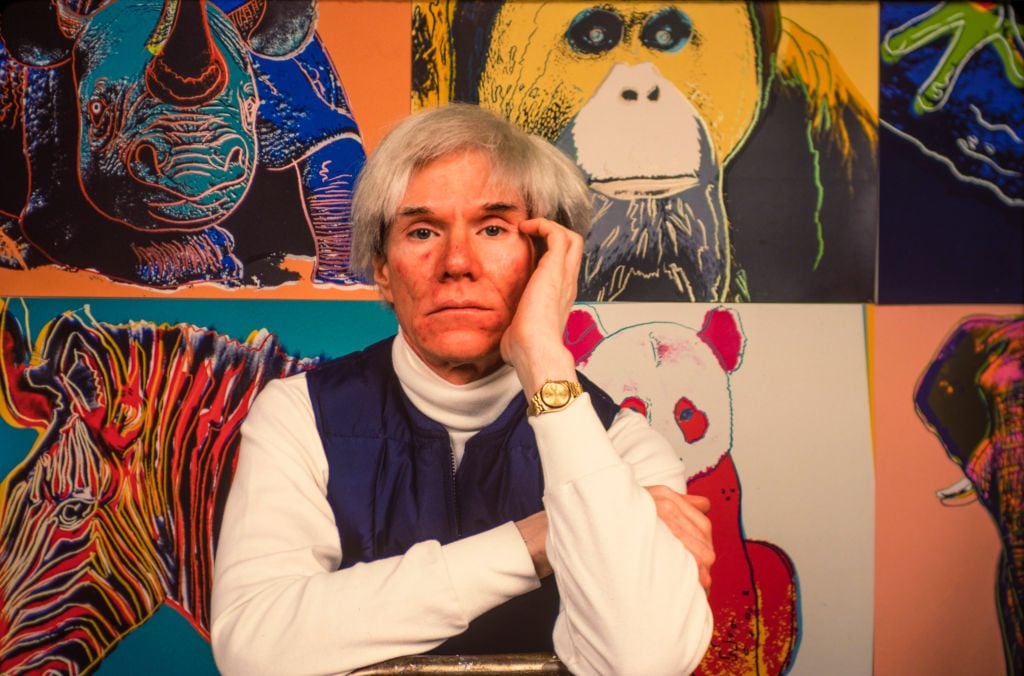Art World
Art Bites: You Can Watch a 24/7 Livestream of Andy Warhol’s Grave
Andy Warhol's final resting place in Pittsburgh has been livestreamed since 2013.

Andy Warhol's final resting place in Pittsburgh has been livestreamed since 2013.

Tim Brinkhof

What’s the deal with Leonardo’s harpsichord-viola? Why were Impressionists obsessed with the color purple? Art Bites brings you a surprising fact, lesser-known anecdote, or curious event from art history. These delightful nuggets shed light on the lives of famed artists and decode their practices, while adding new layers of intrigue to celebrated masterpieces.
On February 22, 1987, Andy Warhol died of complications following gallbladder surgery. The 58-year-old artist was buried four days later at Holy Ghost Byzantine Catholic Church in Pittsburgh, Pennsylvania, which he attended as a child. His grave, located next to those of his mother and father, quickly became a mecca for Modern art lovers.
The site has also been documented in an uninterrupted 24/7 online livestream ever since 2013.
The idea for the livestream came from then-Andy Warhol Museum director Eric Shiner, who was looking for a way to commemorate the artist’s 85th birthday. Shiner employed the help of EarthCam, which maintains a vast network of webcams recording tourist locations across the world. According to the New Yorker, CEO Brian Cury founded the company after being inspired by a meeting with the artist himself, shortly before his death.
We see people are leaving Warhol gifts for the holidays. #warholFigment https://t.co/kHInU2rj12 pic.twitter.com/IzAxHhHO4t
— The Andy Warhol Museum (@TheWarholMuseum) December 17, 2015
“We believe that this will give Warhol the pleasure of knowing that he is still plugged in and turned on over 25 years after his death,” Shiner said of the artist, whose grave already attracted plenty of visitors. Livestream viewers can watch these people decorate the grave with Coca-Cola bottles, Campbell’s Soup cans, and other consumer products Warhol’s art turned into icons. Another webcam, inside the church, shows the space where Warhol was baptized.
just before dusk at andy's grave #warholFigment @TheWarholMuseum pic.twitter.com/d2RtMEasyy
— melissa (@yinzerscience) May 24, 2014
Shiner and Cury named the livestream project Figment, after something Warhol wrote about death. Specifically, his death: “I never understood why when you died, you didn’t just vanish, and everything could just keep going on the way it was only you just wouldn’t be there,” the artist wrote in his 1985 book America. “I always thought I’d like my own tombstone to be blank. No epitaph and no name.”
As Peter Schjeldahl pointed out in that New Yorker article, the project provides a fitting bookend to Warhol’s oeuvre, much of which revolved around death and dying. These themes are especially prevalent in early works like his “Death and Disaster” series, which aestheticizes car crashes, suicides, contaminated tuna cans, and other subjects that typically make for gruesome news stories. Death also plays a role in his later work, which celebrates both pop and consumer culture’s transcendent qualities.
Above all, the livestream suits Warhol because he—like the camera now pointed at his grave—was an unceasing observer of 21st-century society. “I find it Warholian to the, well, life,” Schjeldahl wrote, “watching the present habitation of a man who liked to watch. Warhol pioneered motion pictures of motionless subjects; and we have him to thank, or not, for prophesying reality television. His strictly beholding bent became, as it remains, a default setting of artistic and popular culture absolutely everywhere.”
Of the figment quote, Schjeldahl concluded, “It is the self-assessment of a pure spectator, entirely without connection to what he happened to witness. His demise merely removed one set of eyes and ears from among the world’s billions. That may smack of false modesty; but I think it distills a secret of Warhol’s desolate, desolating power.”